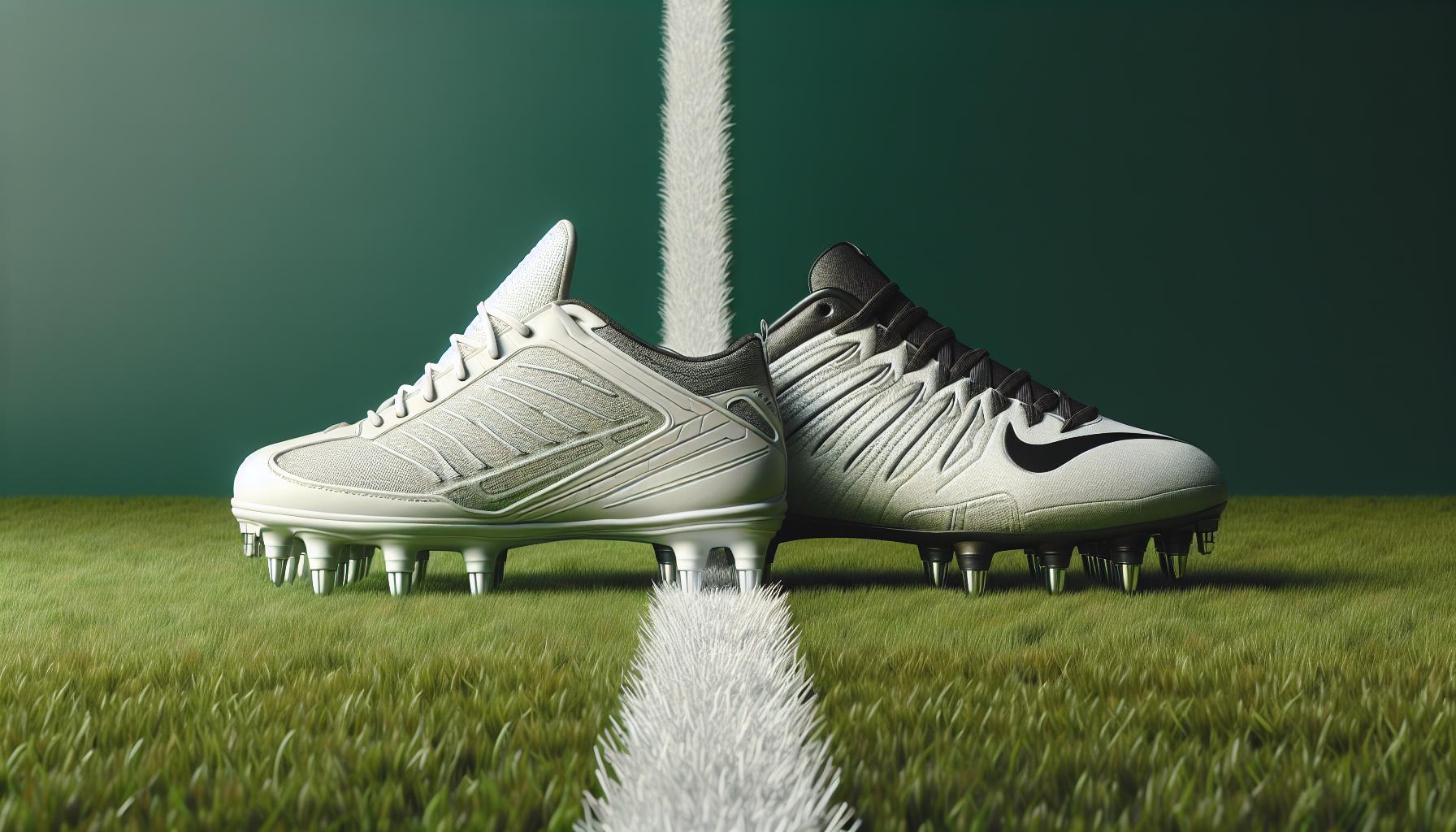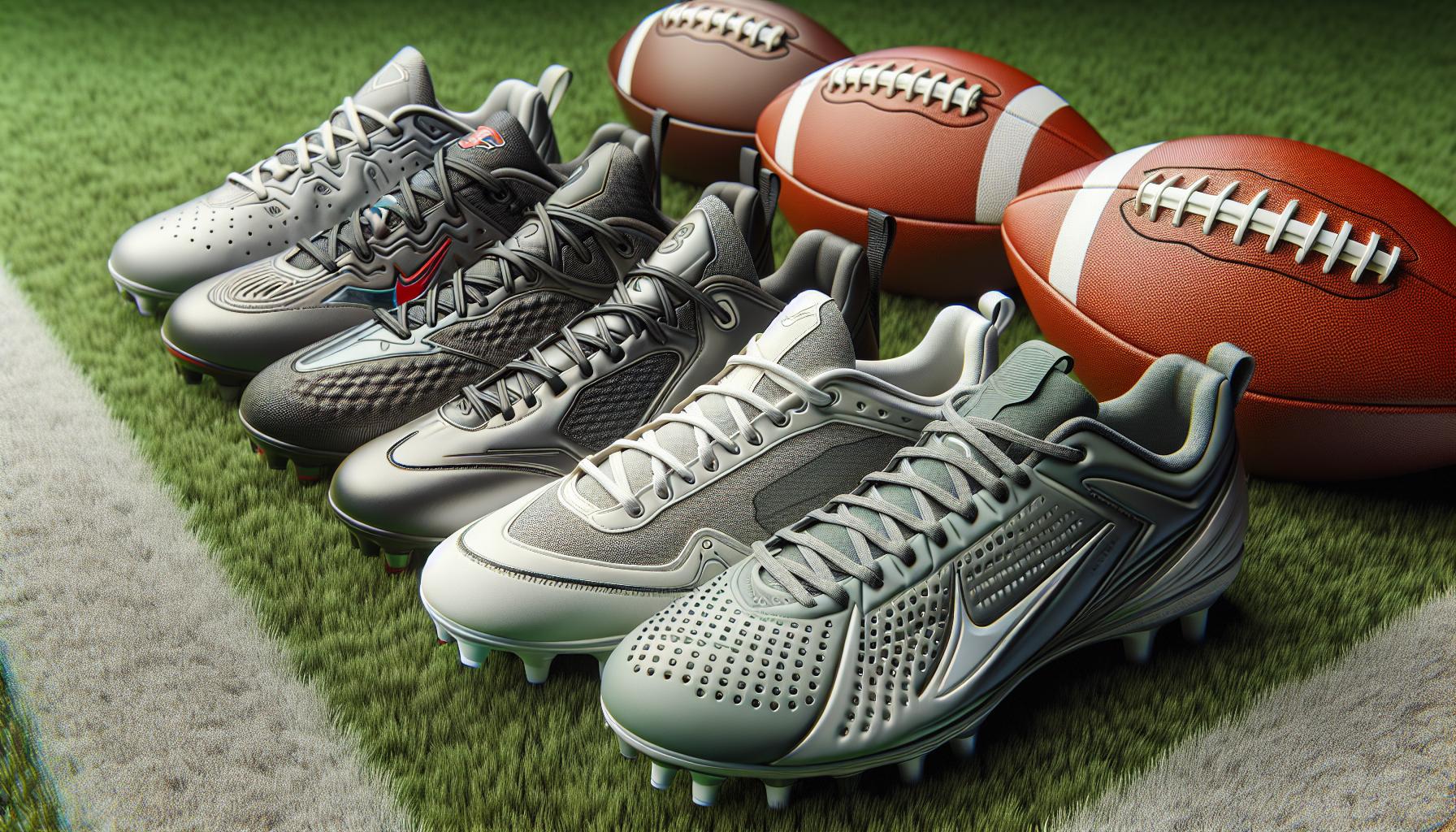
What’s the Difference Between Baseball and Football Cleats? A Comprehensive Guide
Baseball and football may share the field, but their cleats are designed with distinct purposes in mind. Understanding the differences can enhance performance and prevent injuries for athletes in each sport.
Baseball cleats prioritize traction and quick pivots, featuring flatter soles and shorter studs to provide stability during base runs and defensive plays. In contrast, football cleats offer more aggressive traction with longer studs to withstand powerful starts, stops, and rapid directional changes demanded by the game.
Choosing the right cleats ensures players have the optimal support and grip tailored to their sport’s unique movements. Whether you’re sliding into home plate or making a crucial tackle, the right footwear makes all the difference on game day.
Purpose of Cleats in Baseball and Football
Baseball and football cleats serve distinct functions tailored to each sport’s specific movements and demands.
Baseball Cleats
- Stability for Base Running: Designed to provide a firm footing during sprints between bases.
- Quick Pivots: Flat soles and shorter studs enable rapid direction changes without slipping.
- Traction on Dirt and Grass: Optimized for the varied surfaces of baseball fields, ensuring players maintain grip during plays.
Football Cleats
- Enhanced Traction for Aggressive Movements: Longer studs penetrate turf and grass, offering superior grip during sprints and tackles.
- Support for Rapid Direction Changes: Structured soles aid in quick lateral movements essential for evasive maneuvers.
- Durability for High-Impact Play: Built to withstand the physical demands of tackles and constant motion on the field.
| Feature | Baseball Cleats | Football Cleats |
|---|---|---|
| Stud Length | Shorter studs | Longer studs |
| Sole Design | Flatter for stability | Structured for aggressive traction |
| Primary Purpose | Quick pivots and base running | Powerful movements and rapid changes |
| Surface Optimization | Dirt and grass adaptability | Turf and grass penetration |
| Durability Focus | Moderate durability | High durability for impact play |
This differentiation ensures that athletes equip themselves with the appropriate footwear to enhance performance and minimize injury risks in their respective sports.
Design Differences

Baseball and football cleats exhibit distinct design elements tailored to their sport’s demands. These differences enhance performance and provide necessary support on the field.
Stud Patterns and Configuration
Baseball cleats feature a combination of metal or molded studs arranged for optimal traction on dirt and grass. Typically, they have a lower stud count, around 6 to 8 studs per shoe, ensuring stability during quick pivots and base running. Football cleats incorporate a higher number of studs, ranging from 10 to 14, with a mix of longer and shorter studs. This configuration provides aggressive traction for rapid direction changes and high-impact movements on turf and grass surfaces.
Material and Construction
Baseball cleats utilize lightweight materials such as synthetic leather and mesh to allow for quick movement and offer breathability. The construction focuses on flexibility and a snug fit to support swift base running. In contrast, football cleats are built with durable materials like reinforced leather and sturdy plastics to withstand the high-impact nature of the sport. The construction emphasizes support and protection, featuring reinforced ankle collars and robust stitching to handle intense physical play.
Performance and Traction
Enhancing performance and traction is crucial for athletes in both baseball and football. Each cleat type is engineered to meet the specific movement demands of its sport.
Traction on the Field
Baseball cleats feature flatter soles with shorter studs, typically ranging from 6 to 8. This design provides optimal traction on dirt and grass, enabling quick pivots and efficient base running. For example, short metal studs penetrate the infield surfaces, offering stability during sudden direction changes.
Football cleats incorporate longer studs, usually between 10 to 14, with varying lengths for aggressive traction on turf and grass. This configuration supports rapid acceleration and deceleration, essential for powerful movements during plays. The stud arrangement ensures maximum grip, reducing the risk of slipping during high-impact actions.
| Cleat Type | Stud Count | Stud Length | Optimal Surface |
|---|---|---|---|
| Baseball Cleats | 6-8 | Short | Dirt and Grass |
| Football Cleats | 10-14 | Mixed | Turf and Grass |
Stability and Support
Baseball cleats prioritize stability to facilitate quick pivots and sustained base running. Their lower profile and lighter materials minimize weight, allowing players to maintain balance and control during rapid movements. Reinforced ankle support in baseball cleats prevents injuries during sharp turns and sudden stops.
Football cleats emphasize robust support to handle the high-impact nature of the sport. Constructed from durable materials, they offer enhanced ankle protection and cushioning. The sturdy design absorbs shock from powerful tackles and swift directional changes, ensuring players remain stable and protected throughout the game.
| Feature | Baseball Cleats | Football Cleats |
|---|---|---|
| Ankle Support | Reinforced for stability | Enhanced for protection |
| Material | Lightweight and flexible | Durable and shock-absorbent |
| Design Focus | Balance and control | Shock absorption and support |
Sport-Specific Features
Baseball and football cleats incorporate distinct features tailored to their respective sports’ demands. Each design enhances performance and ensures athlete safety through specialized elements.
Baseball Cleats Features
- Stud Configuration: Typically 6 to 8 shorter studs arranged for optimal traction on dirt and grass.
- Material: Lightweight materials provide flexibility and breathability for quick movements.
- Sole Design: Flatter soles enhance stability during base running and sharp pivots.
- Ankle Support: Reinforced ankle support ensures stability during rapid direction changes.
- Breathability: Ventilation features keep feet cool during extended play.
- Stud Configuration: Usually 10 to 14 studs with mixed lengths for aggressive traction on turf and grass.
- Material: Durable materials offer robust support and protection for high-impact play.
- Sole Design: Enhanced traction supports rapid acceleration and quick deceleration.
- Shock Absorption: Built-in shock absorption reduces injury risk during intense movements.
- Reinforced Structures: Extra protection around ankles and feet withstands the sport’s physical demands.
Choosing the Right Cleats
Selecting the appropriate cleats enhances performance and reduces injury risks for athletes in both baseball and football.
Factors to Consider
- Sport-Specific Design
Baseball cleats offer stability for base running and quick pivots. Football cleats provide aggressive traction for rapid movements.
- Surface Type
Baseball cleats excel on dirt and grass with flatter soles. Football cleats perform on turf and grass with longer studs.
- Stud Configuration
Baseball cleats feature 6 to 8 shorter studs for optimal traction. Football cleats incorporate 10 to 14 mixed-length studs for enhanced grip.
- Material and Durability
Baseball cleats use lightweight materials for flexibility and breathability. Football cleats utilize durable materials for robust support and protection.
Fit and Comfort
Proper fit ensures maximum performance and minimizes injury risks. Athletes should try cleats with game socks and consider heel support and toe box space.
Maintenance and Longevity
Regular cleaning extends cleat lifespan. For baseball cleats, remove dirt and mud after games. For football cleats, clean turf residue and check for stud wear.
Price and Budget
Quality cleats vary in price. Baseball cleats range from $50 to $150 based on features. Football cleats typically cost between $60 and $160, depending on brand and specifications.
Brand and Reviews
Trusted brands like Nike, Adidas, and Under Armour offer reliable options. Reviewing athlete feedback helps identify cleats that meet specific performance needs.
Trying Before Buying
Testing cleats on the relevant surface confirms comfort and functionality. In-store trials or returns based on performance can ensure the best choice.
Sizing and Fit Guides
Consult size charts provided by manufacturers. Accurate measurements prevent discomfort and ensure proper support during activities.
Professional Recommendations
Coaches and sports professionals often suggest cleates suited to an athlete’s position and play style. Following expert advice can guide optimal selection.
Technological Features
Advanced cleats include features like enhanced cushioning, shock absorption, and moisture-wicking materials. These technologies improve comfort and performance on the field.
Weight Considerations
Lighter cleats facilitate quicker movements in baseball. Heavier cleats in football offer added stability and support for high-impact plays.
Ankle Support
Baseball cleats provide reinforced ankle support for stability during sharp turns. Football cleats include higher collars and additional padding for protection during physical contact.
Breathability
Ventilation systems in cleats prevent overheating and maintain foot dryness. Baseball cleats prioritize breathability for comfort during long games, while football cleats balance ventilation with durability.
Customization Options
Some cleats offer customizable features like interchangeable studs or adjustable lacing systems. Personalizing cleats can enhance fit and performance tailored to individual preferences.
Legal and League Requirements
Ensure selected cleats comply with league regulations regarding stud type and cleat height. Adhering to rules prevents disqualification and maintains fair play standards.
| Cleat Type | Stud Count | Stud Length | Primary Surface | Material |
|---|---|---|---|---|
| Baseball | 6-8 | Short | Dirt, Grass | Lightweight |
| Football | 10-14 | Mixed | Turf, Grass | Durable |
Choosing the right cleats involves evaluating sport-specific needs, fit, surface compatibility, and additional features to ensure optimal performance and safety.
Conclusion
Choosing the right cleats can make all the difference on the field. Baseball and football cleats are tailored to support the specific movements and demands of each sport. By understanding their unique features athletes can enhance their performance and reduce the risk of injury. Investing in sport-specific footwear ensures players have the support and traction needed to excel. Whether it’s the stability of baseball cleats or the aggressive traction of football cleats, the right choice empowers athletes to perform at their best.
